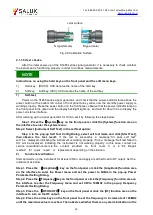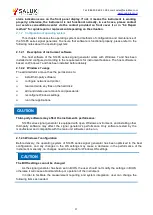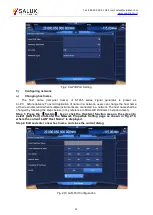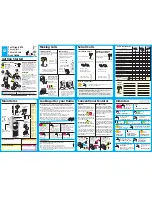
Tel: 886.909 602 109 Email: sales@salukitec.com
29
5)
Use and preservation of connectors
a) Protect the connectors with a protective sheath when not used;
b) Do not place the various connectors, air lines and calibration standards disorderly in a box;
otherwise the connectors will be damaged;
c) Keep the connector and analyzer at the same temperature. If the connector is held by hand or
cleaned with compressed air, the temperature will be significantly changed. The connector can
be used for calibration only after its temperature is stabilized;
d) Do not touch the joint surface of the connector because it is difficult to remove skin oil and dust
particles from the joint surface;
e) Do not place the contact surface of the connector downwards onto a hard surface; otherwise,
the electroplated layer and joint surface of the connector may be damaged.
f)
Wear an anti-static wrist strap and work on a grounded conductive workbench mat to protect the
analyzer and connector against electrostatic discharge.
6)
Cleaning of connectors
It is necessary to wear an anti-static wrist strap when cleaning the connectors as per the following
steps:
a) Use clean low-pressure air to remove the loose particles on the thread and joint surface of the
connector and check the connectors thoroughly. If further cleaning is required, proceed as
follows;
b) Wet (but not soak) a lint-free cotton swab with isopropyl alcohol;
c) Use a cotton swab to remove dirt and debris from the joint surface and thread of the connector.
When cleaning the inner surface, be careful not to apply an external force to the central inner
conductor or leave the cotton swab fibers on the central conductor of the connector;
d) Evaporate the alcohol and then blow the surface clean with compressed air;
e) Check the connectors to confirm that they are free of particles and residues;
f)
If the connector still has visible defects after cleaning, it indicates that the connector may be
damaged. Never use a damaged connector, and confirm the causes of damage before
measurement and connection.
7)
Use of adapter
When the measuring port of analyzer is different from the type of connector used, an adapter
must be adopted for measurement connection. In addition, even if the measurement port of the
analyzer is the same as the type of connector for the port of tested part, it is also a good idea to use
an adapter. Under these two conditions, the measuring port can be protected, thus extending its
service life and reducing the maintenance cost. Before connecting the adapter to the measuring port
of analyzer, it should be carefully checked and cleaned. A high-quality adapter should be used to
reduce the impact of mismatch on the measurement accuracy.
8)
Joint surface of connector
An important concept in microwave measurement is the reference surface for all measurement.
In the case of calibration, the reference surface is defined as the surface on which the measuring port
and the calibration standard arejointed. Proper connection and calibration depend on whether the
connectors can be completely and straightly contact with each other at each point of the joint surface.
















































